MAKS series (original) (raw)

Home - Search - Browse - Alphabetic Index: 0- 1- 2- 3- 4- 5- 6- 7- 8- 9
A- B- C- D- E- F- G- H- I- J- K- L- M- N- O- P- Q- R- S- T- U- V- W- X- Y- Z
MAKS series
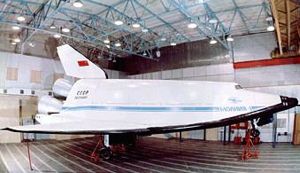
MAKS mockup - side
MAKS mock-up - side view
Credit: Dr.Vadim P.Lukashevich
Russian manned spaceplane. Reached advanced stage of development testing and prototype construction when project was cancelled in 1988. The MAKS spaceplane was the ultimate development of the OK-M studies NPO Molniya conducted with NPO Energia.
Status: Cancelled 1988. Payload: 8,300 kg (18,200 lb). Gross mass: 27,000 kg (59,000 lb). Height: 19.30 m (63.30 ft). Span: 12.50 m (41.00 ft).
The draft project for MAKS was completed in 1988 and consisted of 220 volumes, generated by NPO Molniya and 70 sub-contractors and government institutes. Development of MAKS was authorized but cancelled after Perestroika. At the time of the cancellation, mock-ups of both the MAKS orbiter and the external tank had been finished. A 9,000 kgf experimental engine with 19 injectors was tested. There were 50 test burns proving the separate modes and a smooth switch between them. Since it was expected that MAKS could reduce the cost of transport to earth orbit by a factor of ten, it was hoped in the 1990's that development funding could be found. However this has not happened to date. MAKS was to have flown by 1998.
The MAKS air-launched manned space system weighed 620 metric tons on takeoff and consisted of three elements:
- An-225 Mriya carrier aircraft, the largest in the world, originally developed to transport the Buran orbiter. The Mriya would take the 275 metric ton MAKS piggy-back to an altitude of 8,000 to 9,500 m and then release it at a speed of 900 kph.
- External tank. This carried liquid oxygen, kerosene, and liquid hydrogen propellants. It was 6.38 m in diameter and 32.1 m long, with a total mass of 248,000 kg and an empty mass of 11,000 kg.
- MAKS Orbiter. This spaceplane, designed for 100 reuses, was derived from the OK-M1 designed for NPO Energia. On-board systems were based on those already developed for Energia and Buran. The orbiter had an empty mass of 18,400 kg, with a wingspan of 12.5 m and a length of 19.3 m. An unmanned version could deliver 9.5 metric tons to a 200 km, 51 degree orbit in a payload bay 3.0 m diameter x 8.7 m long. The manned version took two crew and a payload of 8.3 metric tons in a bay 2.6 m diameter x 6.8 m long to the same orbit. At MAKS' tail were two RD-701 tripropellant engines. These were designed for 15 re-uses and used dense kerosene and liquid oxygen for initial operations, then switched modes to a reduced thrust and higher specific impulse using low density liquid hydrogen and liquid oxygen. This reduced the size of the huge hydrogen tank otherwise required. The RD-701 engine assembly in the MAKS had a total mass of 3990 kg and delivered a total thrust of 400,000 kgf at separation from the An-225.
Crew Size: 2.
Subtopics
| MAKS Orbiter LOx/Kerosene/LH2 propellant rocket stage. Empty mass without 9300 kg payload. |
|---|
Family: Space station orbit, Spaceplane. Country: Russia. Agency: Molniya bureau. Bibliography: 302, 458, 89.
Photo Gallery
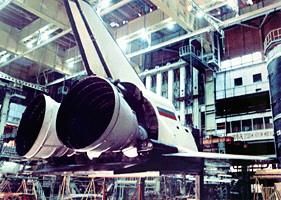 |
MAKS mockup - aftMAKS mock-up - aft view of RD-701 enginesCredit: Dr.Vadim P.Lukashevich |
|---|
 |
MAKS propellant tankMAKS propellant tank mock-upCredit: Dr.Vadim P.Lukashevich |
|---|
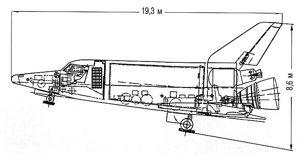 |
MAKS side viewMAKS side view drawingCredit: Dr.Vadim P.Lukashevich |
|---|
 |
MAKS top viewMAKS top view drawingCredit: Dr.Vadim P.Lukashevich |
|---|
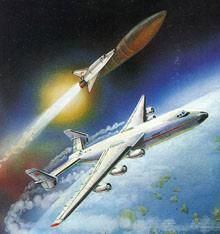 |
MAKS launchMAKS launches from back of An-225Credit: Dr.Vadim P.Lukashevich |
|---|
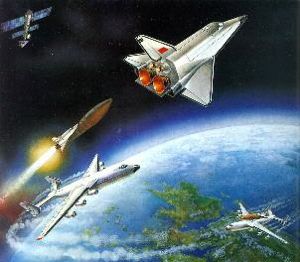 |
MAKS mission profileCredit: Dr.Vadim P.Lukashevich |
|---|
 |
MAKS cutaway drawingCredit: Dr.Vadim P.Lukashevich |
|---|
1988 During the Year - .
- MAKS draft project completed - . Nation: Russia. Spacecraft Bus: MAKS series. Spacecraft: MAKS Orbiter.
The MAKS spaceplane draft project consisted of 220 volumes, generated by NPO Molniya and 70 sub-contractors and government institutes. Development of MAKS was authorised but cancelled after Perestroika. At the time of the cancellation, mock-ups of both the MAKS orbiter and the external tank had been finished. Since it was expected that MAKS could reduce the cost of transport to earth orbit by a factor of ten, it was hoped in the 1990's that development funding could be found. However this has not happened to date.
1989 May - . Launch Vehicle: MAKS.
- MAKS draft project. - . Nation: Russia. Spacecraft Bus: MAKS series. Spacecraft: MAKS Orbiter. MAKS draft project is completed..
Home - Search - Browse - Alphabetic Index: 0- 1- 2- 3- 4- 5- 6- 7- 8- 9
A- B- C- D- E- F- G- H- I- J- K- L- M- N- O- P- Q- R- S- T- U- V- W- X- Y- Z
© 1997-2019 Mark Wade - Contact
© / Conditions for Use